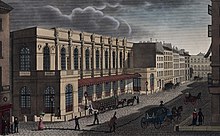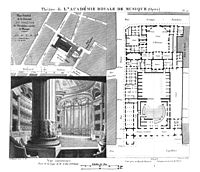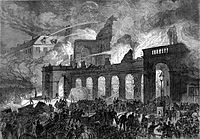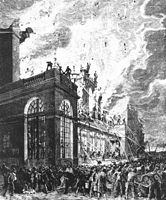Salle Le Peletier




The Salle Le Peletier (sometimes referred to as Salle de la rue Le Peletier or the Opéra Le Peletier ) was the home of the Paris Opera from 1821 until the construction of the new Palais Garnier building in 1873.
history
The theater was planned and built by the architect François Debret on the site of the former Hôtel de Choiseul after the previous house, Théâtre National de la rue de la Loi , had been surrendered . Because of the many organizational and management changes during the existence of this institution, it had a number of official names. The most important were:
- Théâtre de l'Académie Royale de Musique (1821–1848)
- Opéra-Théâtre de la Nation (1848–1850)
- Théâtre de l'Académie Nationale de Musique (1850-1852)
- Théâtre de l'Académie Impériale de Musique (1852-1854)
- Théâtre Impérial de l'Opéra (1854–1870)
- Théâtre National de L'Opéra (1870–1873)
When the nephew (and heir to the throne) of King Louis XVIII, Charles Ferdinand, Duc de Berry, was fatally injured on the night of February 13, 1820 in front of the former theater of the Paris Opera, the Salle de la rue de Richelieu, the decided König to demolish the theater in order to have a memorial chapel built in its place. However, this project was never carried out due to the revolution of 1830. Today the Fontaine Louvois occupies the place where the chapel should have been built on the Louvois square. Very soon after his nephew's death, the king commissioned the architect François Debret to design a new theater for the Opéra on rue Le Peletier, which was completed a year later. During the construction work, the opera and ballet ensembles played in the Théâtre Favart and the Salle Louvois .
The Salle Le Peletier was inaugurated on August 16, 1821 with a mixed program that began with the hymn "Vive Henry VIII" and then included Charles Simon Catel's opera Les Bayadères and the Gardel ballet Le retour de Zéphire . The theater building was planned as a temporary solution made of wood and plaster, but was then used by the Opéra for more than fifty years. Many of the most important operas and ballets of the 19th century were presented on this stage for the first time.
The theater, which was built on an area of 14,000 square meters with a length of 104 meters, was very advanced for its time. On February 6, 1822, gas was used for the first time to achieve the stage effects in Nicolas Isouard's opera Aladin ou La lampe merveilleuse . The sloping stage and orchestra pit could be removed to convert the auditorium into a huge hall that could accommodate large balls and other celebrations.
In 1858, the Salle Le Peletier was the setting for one of the most famous games in chess history, the opera game between the American master Paul Morphy (white) and two French aristocrats, the Duke of Braunschweig and Count Isouard. The game was played in the Duke's private box during a performance by Bellini's Norma .
On the night of October 29, 1873, the Salle Le Peletier met the same fate as many of its predecessors: It was destroyed by a fire that raged for 27 hours, allegedly from the theater's innovative gas lighting. In 1875 the new theater, known today as the Palais Garnier , was inaugurated.
World premieres
Operas
- February 6, 1822 Aladin ou La lampe merveilleuse by Nicolas Isouard
- October 17, 1825 Don Sanche ou Le château d'amour by Franz Liszt
- October 9, 1826 Le siège de Corinthe by Gioachino Rossini
- March 26, 1827 Moïse et Pharaon by Rossini
- February 29, 1828 La muette de Portici by Daniel-François-Esprit Auber
- August 20, 1828 Le comte Ory by Rossini
- August 3, 1829 Guillaume Tell by Rossini
- November 21, 1831 Robert le diable by Giacomo Meyerbeer
- February 27, 1833 Gustave III. ou Le bal masqué by Auber
- February 23, 1835 La Juive by Jacques Fromental Halévy
- February 29, 1836 Les Huguenots by Meyerbeer
- March 5, 1838 Guido et Ginevra ou La peste de Florence by Halévy
- September 3, 1838 Benvenuto Cellini by Hector Berlioz
- April 1, 1839 Le lac des fées by Auber
- April 10, 1840 Les Martyrs by Gaetano Donizetti
- December 2, 1840 La favorite by Donizetti
- December 22, 1841 La rein de Chypre by Halévy
- March 15, 1843 Charles VI of Halévy
- November 13, 1843 Dom Sébastien, roi de Portugal by Donizetti
- November 26, 1847 Jerusalem by Giuseppe Verdi
- April 16, 1849 Le prophète by Meyerbeer
- December 6, 1850 L'enfant prodigue by Auber
- October 18, 1854 La nun sanglante by Charles Gounod
- June 13, 1855 Les vêpres siciliennes by Verdi
- January 12, 1857 Il trovatore by Verdi, Paris version
- March 13, 1861 Tannhäuser by Richard Wagner , Paris version
- April 28, 1865 L'Africaine by Meyerbeer
- March 11, 1867 Don Carlos of Verdi
- March 9, 1868 Hamlet by Ambroise Thomas
- March 19, 1869 Faust von Gounod , second version with ballet
Ballets
- March 12, 1832 La Sylphide , libretto by Adolphe Nourrit , choreography: Filippo Taglioni ; Music: Jean Schneitzhoeffer
- September 21, 1836 La fille du Danube , choreography: Filippo Taglioni; Music: Adolphe Adam
- September 23, 1840 Le diable amoureux , libretto by Saint-George , choreography: Joseph Mazilier ; Music: François Benoist et Napoléon Henri Reber
- June 28, 1841: Giselle, ou les Willis , libretto by Théophile Gautier , choreography: Jean Coralli et Jules Perrot ; Music: Adolphe Adam
- June 22, 1842: La jolie fille de Gand , libretto by Saint-Georges et Albert, choreography: Albert ; Music: Adolphe Adam
- February 22, 1843: La Péri , choreography: Jean Coralli; Music: Friedrich Burgmüller
- August 11, 1845: Le diable à quatre , libretto by Adolphe de Leuven , choreography: Joseph Mazilier ; Music: Adolphe Adam
- April 1, 1846: Paquita , libretto by Paul Foucher , choreography: Joseph Mazilier; Music: Edouard Deldevez
- January 23, 1856: Le corsaire , libretto by Saint-Georges et Joseph Mazilier, choreography: Joseph Mazilier; Music: Adolphe Adam
- November 26, 1860: Le papillon , libretto by Saint-Georges, choreography: Marie Taglioni ; Music: Jacques Offenbach
- November 12, 1866: La Source , libretto by Charles Nuitter , choreography: Arthur Saint-Léon ; Music: Léo Delibes and Ludwig Minkus
- May 25, 1870: Coppélia , libretto by Charles Nuitter by Arthur Saint-Léon, choreography: Arthur Saint-Léon, music: Léo Delibes
gallery
Visit of Tsar Alexander II (1867)
literature
- Patrick Barbier: Opera in Paris, 1800-1850: A Lively History. Amadeus Press, Portland, Oregon 1995, ISBN 0-931340-83-7 .
- Annegret Fauser ; Mark Everist (Ed.): Music, theater, and cultural transfer. Paris, 1830-1914. The University of Chicago Press, Chicago 2009, ISBN 978-0-226-23926-2 .
- Alfred Loewenberg : Annals of Opera 1597-1940 (third edition, revised). Rowman and Littlefield, Totowa, New Jersey 1978, ISBN 0-87471-851-1 .
- Christopher Curtis Mead: Charles Garnier's Paris Opera. The MIT Press, Cambridge, Massachusetts 1991, ISBN 0-262-13275-3 .
- Spire Pitou: The Paris Opéra: an encyclopedia of operas, ballets, composers, and performers (3 volumes). Greenwood Press, Westport, Connecticut 1983, ISBN 978-0-686-46036-7 .
- Nigel Simeone: Paris: a musical gazetteer. Yale University Press, 2000, ISBN 978-0-300-08053-7 .
Web links
- Opéra National de Paris
- Notes on the Académie Royale de Musique from the Scholarly Societies Project
Individual evidence
- ↑ Almanach des spectacles , J.-N. Barba, 1831 p. 23 ( digitized version ).










